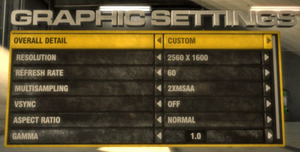Race Driver: GRID
Publisher: CodemastersRace Driver: GRID is one of the best racing games to grace the PC in some time, striking a fine balance between automotive simulation and arcade throttle-fest which has resulted in an enormously entertaining game. Players can choose from racing tuned saloons through city streets, through to driving Lamborghinis around Le Mans, with all cars displaying a highly detailed damage model.
GRID runs on a modified version of Codemasters' own in house Neon engine, rechristened Ego for this game. It will also be the engine used in the highly anticipated Operation Flashpoint 2: Dragon Rising, so hopefully GRID will give us a good indication of how hardware will perform in this future title too. Despite only supporting DirectX 9.0c, GRID features a lot of high level graphical features, including motion blur, fantastic smoke effects, dynamic track side details and thousands of fully 3D spectators.
To test performance in GRID, we raced a lap of the "Circuito Di Milano B" track in the RADT Nissan Skyline Z-tune, starting from the back of the grid to ensure as many cars on screen for as long as possible. We chose the Milan circuit due to the large amount of dynamic track side details like flags and spectators visible from the track, and for the close proximity of track side objects.
However, GRID does not support Anisotropic Filtering in game, so we had to force this to 16x using the Forceware and Catalyst drivers. We captured the average and minimum frame rates during the lap, and the results you see below are indicative of around one minute and forty seconds of gameplay (average lap time) per setting.
Another game, and another situation where the Radeon HD 4870 X2 struggles to scale at lower resolutions - it's again down to a lack of workload to keep all of those little silicon hamsters busy, because as soon as we crank things up to 2,560 x 1,600, we start to see a bit of scaling.
With 2xAA applied at this crazy pixel count, the performance improvement over a single Radeon HD 4870 gets to about 50 percent. Additionally, the 4870 X2 manages to eke out a clear 20 percent gap between it and its closest rival in this title: Nvidia's flagship GeForce GTX 280 card. I'm sure with 4xAA enabled, the gap between the two cards would be even greater, while at the same time I'm sure scaling would also be better still.

MSI MPG Velox 100R Chassis Review
October 14 2021 | 15:04











Want to comment? Please log in.